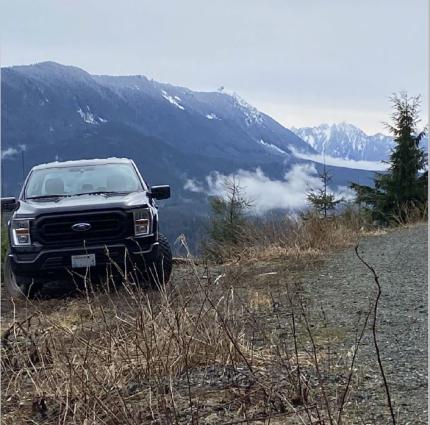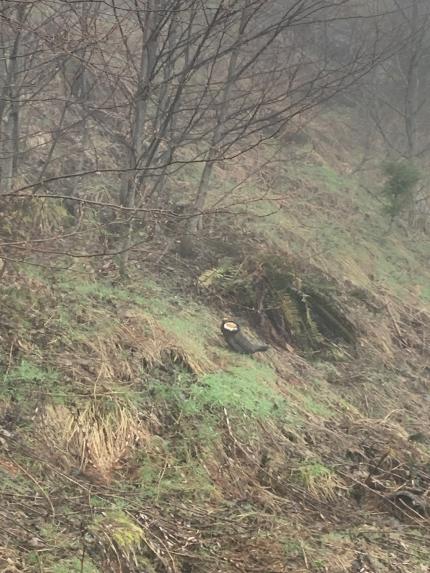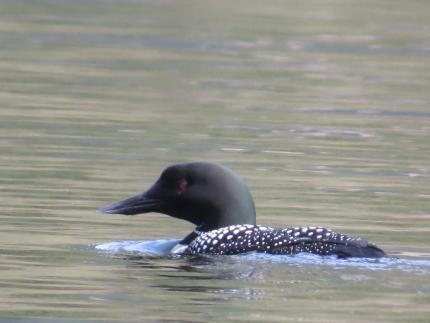Managing Wildlife Populations
Butterfly Monitoring in San Juan County: District Wildlife Biologist Licence assisted Olympia staff members with monitoring multiple butterfly species including the island marble butterfly (IMB) and propertius duskywing on San Juan and Orcas islands respectively. This month marked the first day for a propertius duskywing monitoring and habitat restoration project on San Juan County Land Bank’s, Turtleback Mountain Preserve. The project is funded by a Competitive State Wildlife Grant. While on survey, biologists detected four propertius duskywings (mostly male) and discussed the next steps on the area designated for Gary oak woodland restoration. Staff members also completed the first round of IMB habitat monitoring at Cattle Point, Department of Natural Resources land as well as adult IMB monitoring transects. With only a handful of IMB detected, it appears that the flight season is slightly delayed this year.


Sooty Grouse Hoot Surveys: Biologists Licence, Anderson, Smith and many other west side of Cascade Crest district biologists began surveying for sooty grouse this month. Numerous grouse have been detected on accessible survey routes. Acoustic recording devices were also deployed in ideal locations to help determine when and how long hooting occurs. Monitoring will continue through May.


Purple Martin Colonies on the Seattle Waterfront: Biologists Anderson and Smith conducted the annual collaboration with volunteer stewards to take down used and put up cleaned gourds (natural and plastic super gourds). At least 50 over water gourds, which are only accessible by boat, and many showed occupation from 2022. The group also maintains other sites that are accessible by foot during low tide. The western purple martin is a genetically separate population segment from the eastern purple martin population. They are slightly larger, winter in an entirely different part of Brazil, and do not like to use the well-known “purple martin condominiums” that are so often used east of the Rockies. They are a state Species of Greatest Conservation Need in the Washington State Wildlife Action Plan.


Common Loon Nesting Platform Deployment: Biologist Anderson and Smith deployed multiple loon nesting platforms at lakes known to have recent loon nesting activity. The common loon is a state listed “Sensitive” species and Species of Greatest Conservation Need in the Washington State Wildlife Action Plan. There are only about 30 (or less) nesting pairs in the state of Washington and Washington is the only remaining West Coast state to have nesting loons. They once bred southward, all the way to Mt. Shasta in California. Populations in the western states are being managed to support current populations and hopefully lead to growth in local populations as time progresses. WDFW and our partner, BioDiversity Research Institute (BRI) are in ongoing collaborations to provide for loon needs in Washington (and BRI throughout this species’ range).

Providing Conflict Prevention and Education
Seattle American Robin Tree Removal: Biologist Anderson was contacted by a concerned neighbor as well as a developer regarding a supposed active robin’s nest in tree that was scheduled to be removed. Anderson examined the tree for nesting activity, but none was observed. The developer was not issued any state take. WDFW recommended to have the tree removal entity look over tree prior to cutting and examine it for bird nesting activity as the tree was removed. No bird nests or nesting activity was found by tree removal experts either. Birds and their nests are protected in WAC 220-200-100 and RCW 77.15.130.

Three-legged Cougar Sighting in King County: Biologist Anderson received a note about a three-legged cougar caught on a trail camera. The animal looks healthy and is getting around fine with no reports of any depredations, etc. WDFW is not concerned at this time, and the reporting party was asked to keep in touch if it is seen again.

City of Bellevue Naturalist Program: Biologist Anderson provided an urban wildlife management class for the Bellevue Naturalist Program. Anderson participates in this event annually.
WDFW Opening Inland Freshwater Lakes Day: This year many WDFW employees assisted Fish Program with their annual “Opening Day”. Biologists Smith and Anderson, and many other Region 4 employees staffed various lakes to measure fish and take angler and boat counts for long term trend index needs. Anderson covered Walker Lake and Smith covered Lake Margaret. Anderson did not have a target raptor that he normally surveys for in conjunction with this opening day effort. He did have an osprey the entire time and an active raven’s nest (keeps boat counts interesting!). Smith had a common loon on Lake Margaret, which is a rare breeding bird in Washington with only 30 nesting pairs (a state listed “Sensitive” species). Fishing was good but there were less boat and angler numbers due to colder than usual weather. Anderson and Smith participate in this event annually to help the Fish Program, since they loan a boat to the wildlife biologists annually. It is a great opportunity to educate folks on lead-free tackle and wildlife that are affected by lead fishing products (e.g. loons, osprey taking fish all day, etc.).
Opstad Elementary Science Night in North Bend: Biologist Anderson teamed-up with Bats Northwest to staff a room with information on bat conservation, nighttime wildlife (e.g. northern flying squirrel, barred owl), and other mammalian predators common to Washington (e.g. black bear which is well known in North Bend, and cougar). Bats are the only flying mammal and in Washington and they are the major mammalian predator of insects. They help keep our insect populations in check (think, e.g., apple codling moth as one tasty they gobble up – no worms in apples!). Comparisons to other nighttime animals and mammalian predators were discussed along with basic bat life history, bats of Washington, and bats of the world. It went great and was very well attended. There is much conservation concern over bats of North America due to the bat-specific disease, White-nose syndrome. Find out more about White-nose Syndrome and what you can do.
